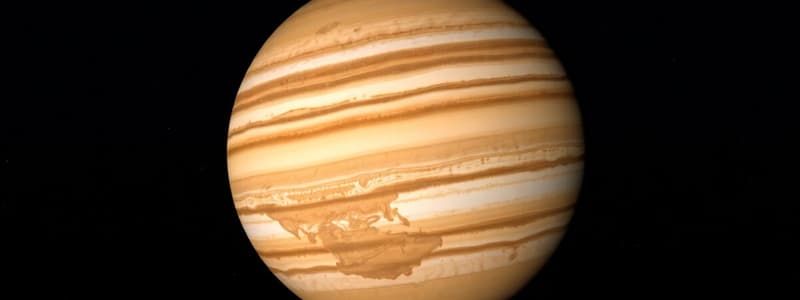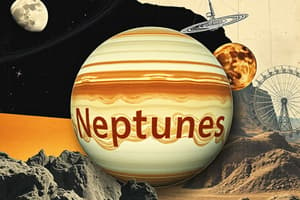Podcast
Questions and Answers
The blue color of Neptune is primarily attributed to the presence of which element in its atmosphere?
The blue color of Neptune is primarily attributed to the presence of which element in its atmosphere?
- Helium
- Methane (correct)
- Ammonia
- Hydrogen
Compared to Earth's winds, Neptune's winds are:
Compared to Earth's winds, Neptune's winds are:
- Approximately the same strength
- Three times stronger
- Weaker due to Neptune's distance from the sun
- Nine times stronger (correct)
The 'Great Dark Spot,' observed on Neptune in 1989, was significant because:
The 'Great Dark Spot,' observed on Neptune in 1989, was significant because:
- It was a newly discovered ring system.
- It was the location of a volcanic eruption.
- It was a massive storm larger than Earth. (correct)
- It caused a significant increase in Neptune's temperature.
How does Triton, Neptune's largest moon, differ from most other large moons in the solar system?
How does Triton, Neptune's largest moon, differ from most other large moons in the solar system?
What evidence suggests that Triton may be geologically active?
What evidence suggests that Triton may be geologically active?
Approximately how long does it take sunlight to travel from the Sun to Neptune?
Approximately how long does it take sunlight to travel from the Sun to Neptune?
What is the significance of Voyager 2's visit to Neptune?
What is the significance of Voyager 2's visit to Neptune?
How does Neptune's density compare to that of the other gas giants in our solar system?
How does Neptune's density compare to that of the other gas giants in our solar system?
In what year did Neptune complete its first orbit since being discovered?
In what year did Neptune complete its first orbit since being discovered?
What is the likely origin of Triton, Neptune's largest moon?
What is the likely origin of Triton, Neptune's largest moon?
Which chemical compound is most abundant in the thick fog of Neptune?
Which chemical compound is most abundant in the thick fog of Neptune?
Which spacecraft, other than Voyager 2, has passed the orbit of Neptune on its way to Pluto?
Which spacecraft, other than Voyager 2, has passed the orbit of Neptune on its way to Pluto?
Approximately how many Earth years does it take Neptune to complete one orbit around the Sun?
Approximately how many Earth years does it take Neptune to complete one orbit around the Sun?
Triton's atmosphere is growing warmer, but scientists do not yet know why. What is the Atmosphere comprised of?
Triton's atmosphere is growing warmer, but scientists do not yet know why. What is the Atmosphere comprised of?
The spacecraft that visited Neptune gathered information about Uranus including its rings and moons in just six hours. After traveling how far and for how long did Voyager 2 collect this information?
The spacecraft that visited Neptune gathered information about Uranus including its rings and moons in just six hours. After traveling how far and for how long did Voyager 2 collect this information?
Which planet is Neptune most similar to?
Which planet is Neptune most similar to?
What name has been given to Neptune, named after the Roman god?
What name has been given to Neptune, named after the Roman god?
How many rings does Neptune have?
How many rings does Neptune have?
In what year was Neptune discovered?
In what year was Neptune discovered?
Flashcards
Neptune
Neptune
The last planet in our solar system, more than 30 times as far from the Sun as Earth.
Neptune's Atmosphere
Neptune's Atmosphere
Hydrogen, helium, and methane. The methane gives Neptune its blue color like Uranus.
Neptune's Wind Speed
Neptune's Wind Speed
Neptune's winds can be three times stronger than Jupiter's and nine times stronger than Earth's.
Neptune's Rings
Neptune's Rings
Signup and view all the flashcards
One Day on Neptune
One Day on Neptune
Signup and view all the flashcards
One Year on Neptune
One Year on Neptune
Signup and view all the flashcards
Number of Neptune's moons
Number of Neptune's moons
Signup and view all the flashcards
Triton
Triton
Signup and view all the flashcards
Voyager 2
Voyager 2
Signup and view all the flashcards
Study Notes
- Neptune is a dark, cold, and very windy planet, and it's the last one in our solar system.
- It is more than 30 times as far from the sun as Earth.
- It is similar to Uranus
- Neptune is composed of a thick fog of water, ammonia, and methane over an Earth-sized solid center.
- It was named after the Roman god of the sea.
- Sunlight takes 4 hours to travel from the Sun to Neptune.
- The atmosphere is made up of hydrogen, helium, and methane.
- Methane is what gives Neptune the same blue color as Uranus.
- Neptune has a thick atmosphere, making it the windiest world in our solar system.
- Winds can be three times stronger than Jupiter's and nine times stronger than Earth's, despite the planet's distance and low energy input from the Sun.
- In 1989, the "Great Dark Spot," a large, oval-shaped storm in Neptune's southern hemisphere, was large enough to contain the entire Earth, but it has since disappeared.
- At least six rings and four more ring arcs exist around Neptune, but they are hard to see.
- A day on Neptune is 16 hours long, while it takes 165 Earth years for it to orbit the sun once.
- Neptune was discovered in 1846, and in 2011, it completed its first 165-year orbit since its discovery.
- Neptune has 14 moons including Triton, its largest, discovered in 1846, 17 days after Neptune.
- Triton is the only large moon in the solar system to orbit backward, suggesting it may have been captured.
- Triton has surface temperatures around minus 235 degrees Celsius making it extremely cold.
- Voyager 2 discovered geysers on Triton spewing icy material upward more than 8 kilometers.
- Triton's thin atmosphere, discovered by Voyager, has been detected from Earth several times and is growing warmer.
Neptune's Exploration
- Voyager 2 is the only spacecraft to have visited Neptune
- After traveling for nine years and 3 billion kilometers, Voyager 2 gathered information about Uranus, including its rings and moons, in only six hours.
- Observations from the Hubble Space Telescope and powerful ground-based telescopes contribute to knowledge of Uranus.
- Voyager 2 discovered 10 new moons, two new rings, and a stronger magnetic field than Saturn.
- On March 18, 2011, New Horizons passed the orbit of Uranus on its way to Pluto.
- This made it the first spacecraft to travel beyond Uranus' orbit since Voyager 2.
- Uranus was not near the crossing point.
- The spacecraft is dormant during the majority of its eight-year interplanetary journey from Jupiter to Pluto.
- To perform necessary checkups, mission controllers wake up New Horizons for 50 days each year.
Studying That Suits You
Use AI to generate personalized quizzes and flashcards to suit your learning preferences.




